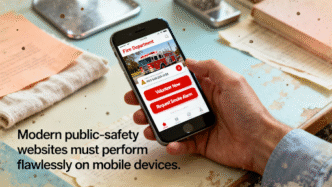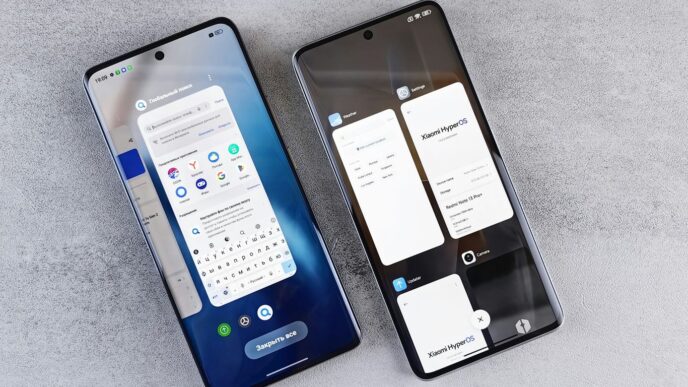A Crisis Measured in Seconds
When people experience a fire, medical emergency, or crash, they rarely reach for a desktop computer—they reach for their phones. For U.S. fire departments, where more than 64 percent of calls involve emergency medical services rather than fires (U.S. Fire Administration), a mobile-ready website is no longer a luxury; it is a necessity. It’s part of the response system.
The Independence Example
That reality drove the Independence Volunteer Fire Department (IVFD) in Louisiana to rebuild its public website in collaboration with BlakSheep Creative, a firefighter- and veteran-owned digital agency. Their redesign—profiled in a recent press feature—is more than a facelift. It’s a model for how civic technology can close the gap between emergency responders and citizens.
“Seconds matter,” says IVFD spokesperson Tommie Spencer. “When someone’s house is filling with smoke or a crash just happened, the last thing they need is a slow or confusing website.”
Performance as a Public-Safety Metric
Every millisecond between an alert and a page load counts. Research from web-performance analysts shows that a two-second delay can raise mobile bounce rates by more than 30 percent. For public safety agencies, that drop-off could mean a resident never finds a critical form or emergency instruction.
BlakSheep’s engineers treated page speed like response time. They implemented:
- Content-delivery network caching for sub-two-second loads,
- Lazy loading for photo-heavy apparatus galleries,
- Preload directives to ensure scripts for emergency banners load before all other content.
It’s not over-engineering; it’s operational readiness translated into code.
Inside the Design Process
Instead of building a flashy template and hoping it worked, BlakSheep developed a workflow familiar to incident-command systems: plan, test, refine. They built prototypes on WordPress using Elementor Pro for layout control and WS Form Pro for data capture. Then they field-tested the site on personal phones—at the station, in vehicles, even during drills.
Those user tests led to interface tweaks that matter under stress, including larger buttons, one-handed navigation, and simplified contact forms. “If a firefighter can fill it out with a gloved thumb, it’s ready for the public,” Sanchez quips.
Policy & Compliance Context
The modernization aligns with federal standards. FEMA’s Integrated Public Alert and Warning System (IPAWS) requires that linked websites be mobile-friendly and stable under heavy traffic (FEMA IPAWS overview). If an IPAWS alert directs residents to a local site that takes too long to load, the chain of communication fails.
Similarly, new ADA Title II rules finalized in 2024 require local government websites to conform to WCAG 2.2 Level AA accessibility guidelines. Designing mobile-first naturally supports that—clear structure, contrast, and keyboard navigation are easier to achieve when starting with constrained layouts.
“Accessibility and speed are the same conversation,” Sanchez explains. “If your site loads fast and everyone can use it, you’ve already solved half the compliance problem.”
Operational Impact
Since IVFD launched its new site, metrics tell the story:
- Volunteer-interest form completions up 42 percent,
- Average session duration up 35 percent,
- Mobile traffic shares up to 82 percent of total visitors.
Residents can now request smoke alarms or event information without having to scroll through dense menus—department staff update alerts directly from phones, cutting publication time from hours to minutes.
BlakSheep’s modular architecture also provided IVFD with control, eliminating dependence on outside developers. “We designed it so the department can edit in real time,” says Sanchez. “They don’t have to call us at 2 a.m. to post an evacuation notice.”
The Broader Digital Movement
IVFD isn’t alone. Departments in Texas, Tennessee, and Pennsylvania have adopted similar cloud-based platforms. During regional storms or wildfires, these mobile-first sites handle tenfold traffic spikes while continuing to serve forms and updates.
The trend reflects a cultural shift, as small agencies are embracing enterprise-grade digital performance. As one Tennessee chief put it, “If Amazon can tell me where my package is in real time, our residents should know where to get safety info just as easily.”
Future-Proofing Public-Safety Communication
The next frontier goes beyond mobile layouts. Agencies are beginning to integrate:
- Chatbots trained on department FAQs,
- GIS dashboards overlaying incident data and weather patterns,
- Multilingual voice interfaces for diverse communities.
BlakSheep’s build anticipates this evolution. Its back-end supports APIs that could connect dispatch data, real-time alerts, or language toggles without a rebuild. “Technology is part of fire-service culture now,” Sanchez says. “A modern department has to think like a newsroom, a data center, and an emergency crew simultaneously.”
The Takeaway
Public safety communication relies on credibility, clarity, and speed. Mobile-first design delivers all three. The IVFD example shows that with the right digital partner and a service-driven mindset, even small volunteer departments can operate with enterprise-level responsiveness.
In emergencies, the public doesn’t distinguish between the fire truck and the website—they just need both to arrive fast.












